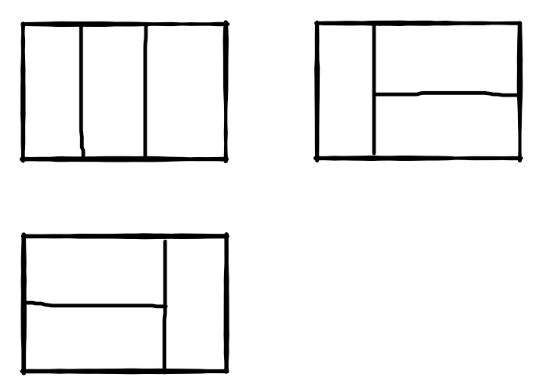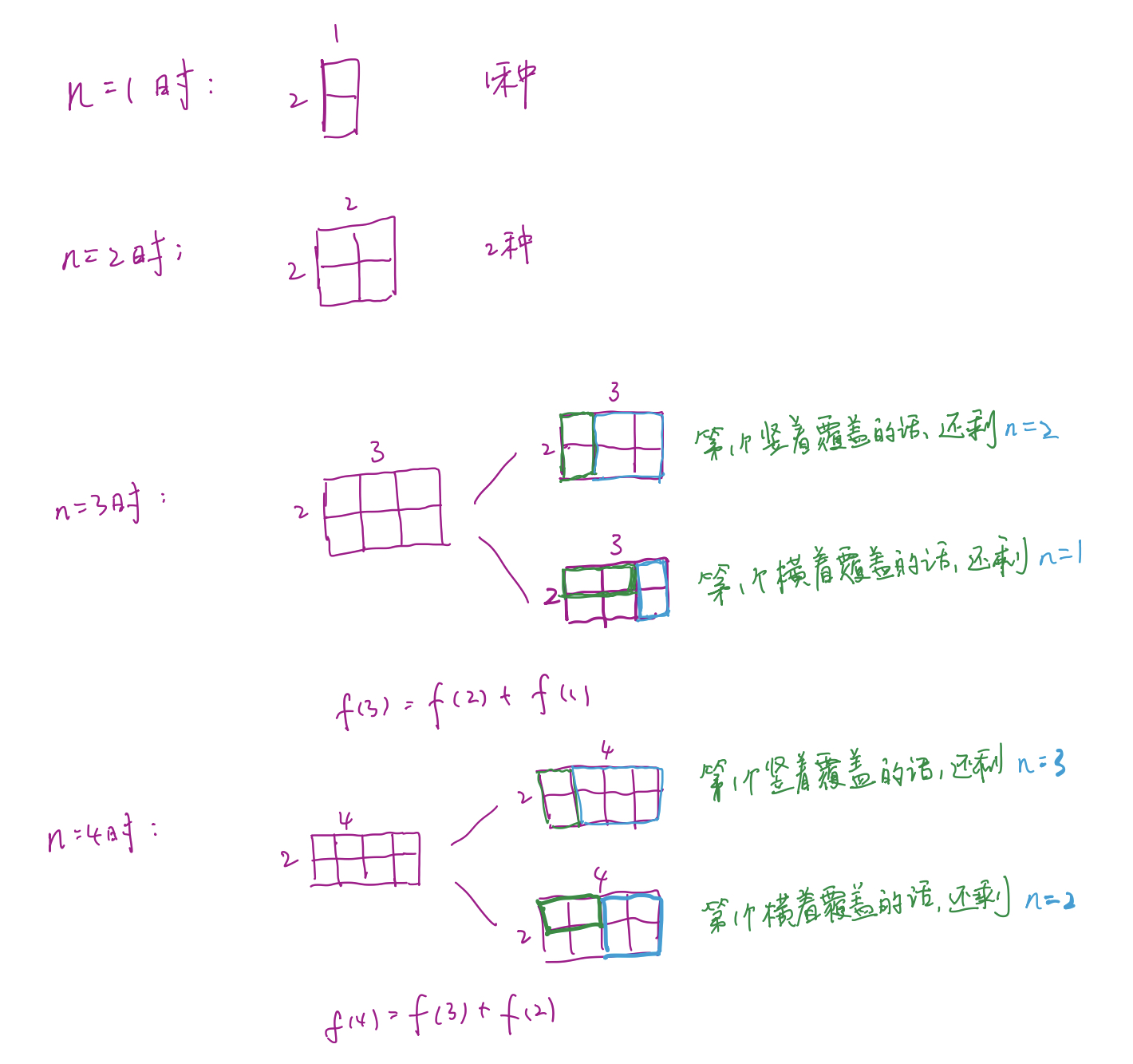牛客-剑指offer
二维数组中的查找
https://www.nowcoder.com/practice/abc3fe2ce8e146608e868a70efebf62e?tpId=13&tqId=11154&tPage=1&rp=1&ru=/ta/coding-interviews&qru=/ta/coding-interviews/question-ranking
题目描述:
在一个二维数组中(每个一维数组的长度相同),每一行都按照从左到右递增的顺序排序,每一列都按照从上到下递增的顺序排序。请完成一个函数,输入这样的一个二维数组和一个整数,判断数组中是否含有该整数。
方法:
从左下找
https://www.nowcoder.com/questionTerminal/abc3fe2ce8e146608e868a70efebf62e?answerType=1&f=discussion
对于左下角的值 m,m 是该行最小的数,是该列最大的数 每次将 m 和目标值 target 比较:
- 当 m < target,由于 m 已经是该行最大的元素,想要更大只有从列考虑,取值右移一位
- 当 m > target,由于 m 已经是该列最小的元素,想要更小只有从行考虑,取值上移一位
- 当 m = target,找到该值,返回 true
用某行最小或某列最大与 target 比较,每次可剔除一整行或一整列
1 | public class Solution { |
复杂度:
时间复杂度:O(行高 + 列宽) 空间复杂度:O(1)
从尾到头打印链表
https://www.nowcoder.com/practice/d0267f7f55b3412ba93bd35cfa8e8035?tpId=13&tqId=11156&rp=1&ru=/ta/coding-interviews&qru=/ta/coding-interviews/question-ranking
题目描述:
输入一个链表,按链表从尾到头的顺序返回一个ArrayList。
法一:将链表翻转,再依次加入ArrayList
1 | /** |
法二:利用ArrayList的方法add(int index, E element),每次将链表中的元素添加至索引0处
1 | /** |
复杂度:
时间复杂度:O(n) 空间复杂度:O(n)
重建二叉树
https://www.nowcoder.com/practice/8a19cbe657394eeaac2f6ea9b0f6fcf6?tpId=13&tqId=11157&tPage=1&rp=1&ru=/ta/coding-interviews&qru=/ta/coding-interviews/question-ranking
题目描述:
输入某二叉树的前序遍历和中序遍历的结果,请重建出该二叉树。假设输入的前序遍历和中序遍历的结果中都不含重复的数字。例如输入前序遍历序列{1,2,4,7,3,5,6,8}和中序遍历序列{4,7,2,1,5,3,8,6},则重建二叉树并返回。
方法:
递归
根据中序遍历和前序遍历可以确定二叉树,具体过程为:
- 根据前序序列第一个结点确定根结点
- 根据根结点在中序序列中的位置分割出左右两个子序列
- 对左子树和右子树分别递归使用同样的方法继续分解
1 | /** |
复杂度:
时间复杂度:O(n) 空间复杂度:O(n)
用两个栈实现队列
https://www.nowcoder.com/practice/54275ddae22f475981afa2244dd448c6?tpId=13&tqId=11158&tPage=1&rp=1&ru=/ta/coding-interviews&qru=/ta/coding-interviews/question-ranking
题目描述:
用两个栈来实现一个队列,完成队列的Push和Pop操作。 队列中的元素为int类型。
1 | import java.util.Stack; |
旋转数组的最小数字
https://www.nowcoder.com/practice/9f3231a991af4f55b95579b44b7a01ba?tpId=13&tqId=11159&tPage=1&rp=1&ru=/ta/coding-interviews&qru=/ta/coding-interviews/question-ranking
题目描述:
把一个数组最开始的若干个元素搬到数组的末尾,我们称之为数组的旋转。 输入一个非递减排序的数组的一个旋转,输出旋转数组的最小元素。 例如数组{3,4,5,1,2}为{1,2,3,4,5}的一个旋转,该数组的最小值为1。 NOTE:给出的所有元素都大于0,若数组大小为0,请返回0。
1 | public class Solution { |
斐波那契数列
https://www.nowcoder.com/practice/c6c7742f5ba7442aada113136ddea0c3?tpId=13&tqId=11160&tPage=1&rp=1&ru=/ta/coding-interviews&qru=/ta/coding-interviews/question-ranking
题目描述:
大家都知道斐波那契数列,现在要求输入一个整数n,请你输出斐波那契数列的第n项(从0开始,第0项为0)。
n<=39
方法:
优化动态规划
1 | public class Solution { |
复杂度:
时间复杂度:O(n) 空间复杂度:O(1)
跳台阶
https://www.nowcoder.com/practice/8c82a5b80378478f9484d87d1c5f12a4?tpId=13&tqId=11161&tPage=1&rp=1&ru=/ta/coding-interviews&qru=/ta/coding-interviews/question-ranking
题目描述:
一只青蛙一次可以跳上1级台阶,也可以跳上2级。求该青蛙跳上一个n级的台阶总共有多少种跳法(先后次序不同算不同的结果)。
方法:
优化动态规划
1 | public class Solution { |
复杂度:
时间复杂度:O(n) 空间复杂度:O(1)
变态跳台阶
https://www.nowcoder.com/practice/22243d016f6b47f2a6928b4313c85387?tpId=13&tqId=11162&tPage=1&rp=1&ru=/ta/coding-interviews&qru=/ta/coding-interviews/question-ranking
题目描述:
一只青蛙一次可以跳上1级台阶,也可以跳上2级……它也可以跳上n级。求该青蛙跳上一个n级的台阶总共有多少种跳法。
方法:
易知 f(n)=f(n-1)+f(n-2)+……f(1) f(n-1)=f(n-2)+……f(1) 两式相减得f(n)=2f(n-1)
1 | public class Solution { |
矩形覆盖
https://www.nowcoder.com/practice/72a5a919508a4251859fb2cfb987a0e6?tpId=13&tqId=11163&tPage=1&rp=1&ru=/ta/coding-interviews&qru=/ta/coding-interviews/question-ranking
题目描述:
我们可以用2*1的小矩形横着或者竖着去覆盖更大的矩形。请问用n个2*1的小矩形无重叠地覆盖一个2*n的大矩形,总共有多少种方法?
比如n=3时,2*3的矩形块有3种覆盖方法:

方法:迭代
类似斐波那契数列
f(n) = f(n-1) + f(n-2)

1 | public class Solution { |
二进制中1的个数
https://www.nowcoder.com/practice/8ee967e43c2c4ec193b040ea7fbb10b8?tpId=13&tqId=11164&tPage=1&rp=1&ru=/ta/coding-interviews&qru=/ta/coding-interviews/question-ranking
题目描述:
输入一个整数,输出该数二进制表示中1的个数。其中负数用补码表示。
(注:输入的是二进制表示形式)
方法:
一个二进制数减去1,再和原二进制数做与运算,会把该数最右边的1变为0,那么一个整数的二进制有多少个1,就可以进行多少次这样的操作。
https://www.nowcoder.com/questionTerminal/8ee967e43c2c4ec193b040ea7fbb10b8?answerType=1&f=discussion
举个例子:一个二进制数1100,减去1后,结果为1011。我们发现减1的结果是把最右边的一个1开始的所有位都取反了。这个时候如果我们再把原来的整数和减去1之后的结果做与运算,从原来整数最右边一个1那一位开始所有位都会变成0。如1100&1011=1000.
1 | public class Solution { |
数值的整数次方
https://www.nowcoder.com/practice/1a834e5e3e1a4b7ba251417554e07c00?tpId=13&tqId=11165&tPage=1&rp=1&ru=/ta/coding-interviews&qru=/ta/coding-interviews/question-ranking
题目描述:
给定一个double类型的浮点数base和int类型的整数exponent。求base的exponent次方。
保证base和exponent不同时为0
1 | public class Solution { |
调整数组顺序使奇数位于偶数前面
题目描述:
输入一个整数数组,实现一个函数来调整该数组中数字的顺序,使得所有的奇数位于数组的前半部分,所有的偶数位于数组的后半部分,并保证奇数和奇数,偶数和偶数之间的相对位置不变。
思路:
https://www.nowcoder.com/questionTerminal/beb5aa231adc45b2a5dcc5b62c93f593?answerType=1&f=discussion
i++往前走,碰到偶数停下来,j=i+1- 若
a[j]为偶数,j++前进,直到碰到奇数a[j]对应的奇数插到a[i]位置,j经过的j-1个偶数依次后移
- 如果
j==len-1时还没碰到奇数,证明i和j之间都为偶数了,完成整个移动
1 | public class Solution { |
链表中第k个结点
https://www.nowcoder.com/practice/529d3ae5a407492994ad2a246518148a?tpId=13&tqId=11167&tPage=1&rp=1&ru=/ta/coding-interviews&qru=/ta/coding-interviews/question-ranking
题目描述:
输入一个链表,输出该链表中倒数第k个结点。
方法:快慢指针
快指针先往前走k步,注意判断边界,然后快慢一起走,当快指针为null的时候,慢指针走到了倒数第k个节点
1 | /* |
反转链表
https://www.nowcoder.com/practice/75e878df47f24fdc9dc3e400ec6058ca?tpId=13&tqId=11168&tPage=1&rp=1&ru=/ta/coding-interviews&qru=/ta/coding-interviews/question-ranking
题目描述:
输入一个链表,反转链表后,输出新链表的表头。
1 | /* |
合并两个排序的链表
https://www.nowcoder.com/practice/d8b6b4358f774294a89de2a6ac4d9337?tpId=13&tqId=11169&tPage=1&rp=1&ru=/ta/coding-interviews&qru=/ta/coding-interviews/question-ranking
题目描述:
输入两个单调递增的链表,输出两个链表合成后的链表,当然我们需要合成后的链表满足单调不减规则。
方法:递归
1 | /* |
树的子结构
https://www.nowcoder.com/practice/6e196c44c7004d15b1610b9afca8bd88?tpId=13&tqId=11170&tPage=1&rp=1&ru=/ta/coding-interviews&qru=/ta/coding-interviews/question-ranking
题目描述:
输入两棵二叉树A,B,判断B是不是A的子结构。(ps:我们约定空树不是任意一个树的子结构)
1 | /** |
注意与子树的区别:
https://www.nowcoder.com/questionTerminal/6e196c44c7004d15b1610b9afca8bd88?answerType=1&f=discussion
二叉树的镜像
https://www.nowcoder.com/practice/564f4c26aa584921bc75623e48ca3011?tpId=13&tqId=11171&tPage=1&rp=1&ru=/ta/coding-interviews&qru=/ta/coding-interviews/question-ranking
题目描述:
操作给定的二叉树,将其变换为源二叉树的镜像。
输入描述:
二叉树的镜像定义:
源二叉树 8 /
6 10 / /
5 7 9 11 镜像二叉树 8 /
10 6 / /
11 9 7 5
思路:
交换左右子树的节点,然后递归调用该方法。
1 | /** |
顺时针打印矩阵
https://www.nowcoder.com/practice/9b4c81a02cd34f76be2659fa0d54342a?tpId=13&tqId=11172&tPage=1&rp=1&ru=/ta/coding-interviews&qru=/ta/coding-interviews/question-ranking
题目描述:
输入一个矩阵,按照从外向里以顺时针的顺序依次打印出每一个数字,例如,如果输入如下4 X 4矩阵: 1 2 3 4 5 6 7 8 9 10 11 12 13 14 15 16 则依次打印出数字1,2,3,4,8,12,16,15,14,13,9,5,6,7,11,10.
思路:
https://www.nowcoder.com/questionTerminal/9b4c81a02cd34f76be2659fa0d54342a?answerType=1&f=discussion
- 向右走存入整行的值,当存入后,该行再也不会被遍历,代表上边界的 up 加一,同时判断是否和代表下边界的 down 交错
- 向下走存入整列的值,当存入后,该列再也不会被遍历,代表右边界的 right 减一,同时判断是否和代表左边界的 left 交错
- 向左走存入整行的值,当存入后,该行再也不会被遍历,代表下边界的 down 减一,同时判断是否和代表上边界的 up 交错
- 向上走存入整列的值,当存入后,该列再也不会被遍历,代表左边界的 left 加一,同时判断是否和代表右边界的 right 交错
1 | import java.util.ArrayList; |
包含min函数的栈
https://www.nowcoder.com/practice/4c776177d2c04c2494f2555c9fcc1e49?tpId=13&tqId=11173&tPage=1&rp=1&ru=/ta/coding-interviews&qru=/ta/coding-interviews/question-ranking
题目描述:
定义栈的数据结构,请在该类型中实现一个能够得到栈中所含最小元素的min函数(时间复杂度应为O(1))。
注意:保证测试中不会当栈为空的时候,对栈调用pop()或者min()或者top()方法。
思路:
关键在于若用一个int来保存最小值,被pop出去了后怎么办:
使用两个栈,一个保存所有的元素,另一个用来保存历史最小值。
当pop()时,检查stack与minStack的栈顶元素是否相同,若相同则都pop(),否则只需pop stack.
1 | import java.util.Stack; |
栈的压入、弹出序列
https://www.nowcoder.com/practice/d77d11405cc7470d82554cb392585106?tpId=13&tqId=11174&tPage=2&rp=2&ru=/ta/coding-interviews&qru=/ta/coding-interviews/question-ranking
题目描述:
输入两个整数序列,第一个序列表示栈的压入顺序,请判断第二个序列是否可能为该栈的弹出顺序。假设压入栈的所有数字均不相等。例如序列1,2,3,4,5是某栈的压入顺序,序列4,5,3,2,1是该压栈序列对应的一个弹出序列,但4,3,5,1,2就不可能是该压栈序列的弹出序列。(注意:这两个序列的长度是相等的)
思路:
新建一个栈,将数组A压入栈中,只要栈顶元素等于数组B时,就将其出栈,当循环结束时,判断栈是否为空,若为空则返回true.
1 | import java.util.ArrayList; |
从上往下打印二叉树
https://www.nowcoder.com/practice/7fe2212963db4790b57431d9ed259701?tpId=13&tqId=11175&tPage=2&rp=2&ru=/ta/coding-interviews&qru=/ta/coding-interviews/question-ranking
题目描述:
从上往下打印出二叉树的每个节点,同层节点从左至右打印。
思路:
https://www.nowcoder.com/questionTerminal/7fe2212963db4790b57431d9ed259701?answerType=1&f=discussion
每一次打印一个节点的时候,如果该节点有子节点,则把该节点的子节点放到一个队列的尾部。接下来到对队列的头部取出最早进入队列的节点放到ArrayList 中,重复前面的操作,直至队列为空。
1 | import java.util.ArrayList; |